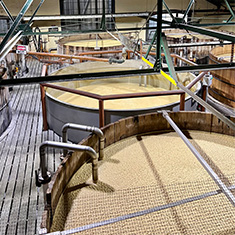
By Chris Brown, Business Unit Manager & Principal
Creating a rich, well-balanced bourbon is an art form. Makers must understand the distilling process—from the initial ingredient selection and aging to bottling and shipping—to ensure a quality product. But there’s another team behind the distillers crucial to the making process: civil engineers.
These unsung heroes provide the foundation for a successful distillery. Their involvement ranges from initial site selection and collaborative design to modernization and expansion with a team made up of structural, traffic, drainage, process, and mechanical, electrical, and plumbing (MEP) engineers.
In my work with Bowman, we have worked closely with multiple Kentucky bourbon distillers, including Four Roses Bourbon in Lawrenceburg and Heaven Hill Distillery in Bardstown, to support initial builds and/or expansion projects, all of which come with unique challenges. We have also done some smaller process-related projects with Brown-Forman Distillery, Buffalo Trace Distillery, and Northwest Ordinance Distilling.
Here are four crucial aspects to consider when building or expanding a distillery.
Collaboration
Creating or expanding a distillery must be a team effort to ensure a smooth, efficient building process with an effective end result. Distillers start with a vision. Surveyors and engineers begin the process ensuring the proposed project is safe and feasible. Then come planning and zoning experts, civil, MEP, process, structural engineers, architects, and builders who work together to bring that vision to life. The process requires meticulous planning, phasing, and effective communication across multiple entities.
Topography
Kentucky’s unique, rocky topography is what gives its bourbon its distinctive taste. The water used in the distilling process filters through layers of limestone, picking up flavorful minerals and eliminating bitter elements. But this important terrain can also be a challenge when embarking on a new build distillery or expansion project.
Thorough surveying of the land is a crucial first step for any effective new build or expansion. Extreme land grades, reservoirs, greenfields, or brownfields must be accounted for in assessing the safest, most effective means of land disturbance. An ideal site must have a supportive infrastructure—including access to roadways, utilities, and a water supply—in addition to an adequate amount of usable land. A poor understanding of a site’s terrain can lead to costly or even dangerous consequences when it comes time to build.
To do this, Bowman uses 3D laser scanning to survey the site pre-construction. These lasers use Light Detection and Ranging (LIDAR) technology to collect millions of spatial data points that are then used to create an accurate rendering of the land. This provides an essential foundation to work from when designing the new build or expansion.
Maintaining Production At The Distillery
In our work with Four Roses and Heaven Hill, our goal was to expand the distillery to meet demand and increase customer experience.
The Four Roses expansion was developed to increase production capacity by 50 percent, which included installing 25 new fermenters, upgrading equipment, and constructing several new buildings, including a new visitors’ center. Many of the original buildings were updated and modified to maintain their architectural accuracy and history and to accommodate new equipment and visitors’ tour routes.
Our work with Heaven Hill included a 20,000-square-foot expansion of the heritage center to include an event space and upgraded visitors’ center experience with an added restaurant and bar.
In both cases, we needed to undergo this process without affecting current bourbon production or the visitor experience. This meant working around existing drives, parking, and other defined areas while maintaining ADA accessibility in addition to the distillery itself.
Strategic planning was a crucial aspect of this process, working closely with the distillers to develop an extensive, multi-phased plan that would focus on smaller, specific aspects of the project at a time to minimize disturbance.
Aging Structures and Modernization Of The Distillery
entucky’s expertise in developing its renowned bourbon comes from decades of experience. The challenge for engineers, however, is working with aging infrastructures and updating them in a way that maintains the historic character of the buildings while integrating modern technology.
Built in 1910, Four Roses featured a unique Spanish Mission-style architecture rarely seen in Kentucky. It is listed on the National Register of Historic Places. The effort required 3-D laser scanning and traditional ground surveying along with careful planning and zoning expertise to ensure safe structural upgrades that maintained the buildings’ historic features.
While established in 1935, the current Heaven Hill Bourbon Experience was originally built in 2004. Many warehouses on the same property still contained historical elements of the property, especially in areas where the bourbon is stored and distributed. Bowman’s work with them focused mainly on expanding the visitor center by incorporating modern technology into historic structures which is also crucial for safety.
In 1996, Heaven Hill suffered a major fire during a storm, which burned down the distillery and seven rickhouses and literally sent barrels of flaming bourbon down the river, resulting in a $30 million loss. Modern safety codes and practices now incorporate new design and construction methods that reduce the risk of these issues to again cause major losses and damage.
The Future of Modern Distilling
A strong foundation is crucial for the success of any project. That is especially true in the case of distilleries where mistakes in calculations could result in a poor product at best or major destruction or injury at worst. Technology is evolving daily, and keeping distilleries updated and modernized is important for maintaining and growing a strong business, whether through improving efficiencies, expanding production, or protecting structures and people.
This article first appeared in The Whiskey Wash.
Tags:Insights



